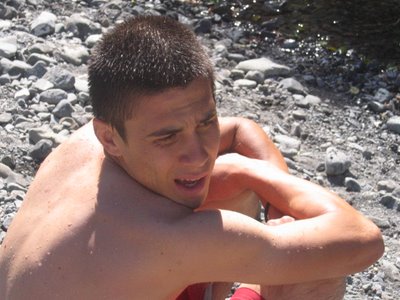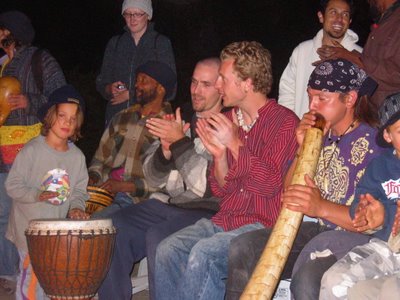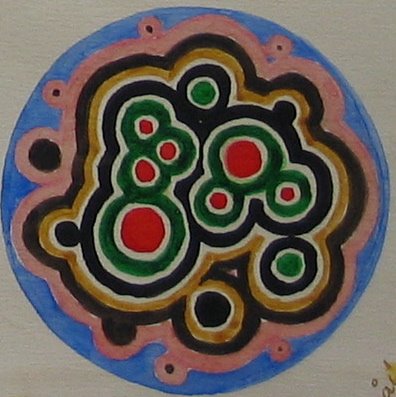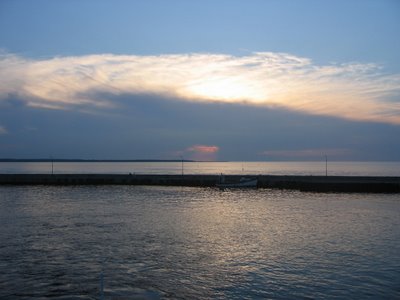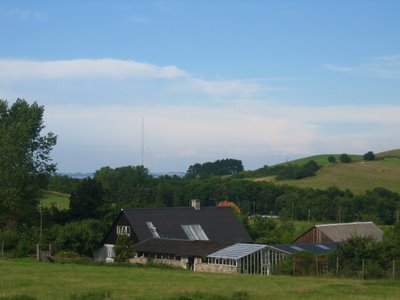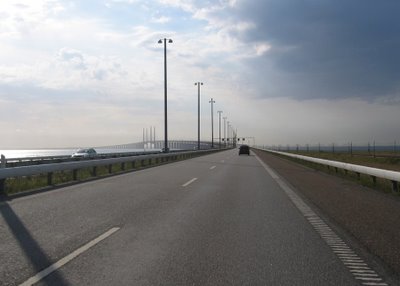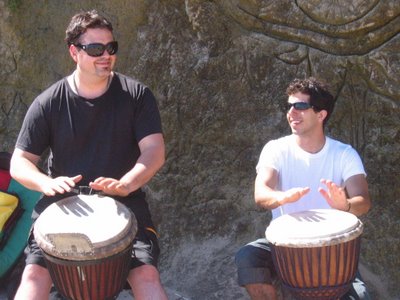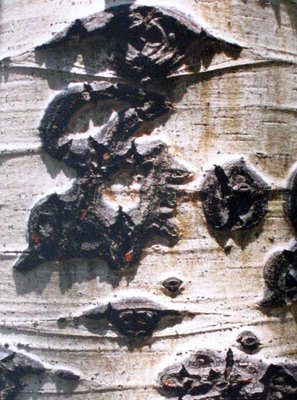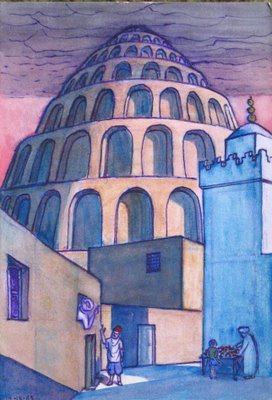 I foumd this image on the net and I like it a lot. It's really bizarre, but so innocently authentic - and i love alphabets too.
I foumd this image on the net and I like it a lot. It's really bizarre, but so innocently authentic - and i love alphabets too.
Saturday, September 30, 2006
Forward to the Past.
 I foumd this image on the net and I like it a lot. It's really bizarre, but so innocently authentic - and i love alphabets too.
I foumd this image on the net and I like it a lot. It's really bizarre, but so innocently authentic - and i love alphabets too.
Friday, September 29, 2006
Wednesday, September 27, 2006
Oxbøl
When I was drafted to three weeks of retraining in the army I declared myself conscientious objector and had to serve instead six weeks in Oxbøl camp.
Oxbøl was a camp for 10,000 people created by the German army during the occupation and was now after the war being dismantled by conscientious objectors. We had to dig up old roads and separate the stones from the gravel. We were supposed to produce a certain amount of cubic feet per day, but since we were only there for a short time the staff didn’t enforce the rules strictly on us. We did some work because it was winter and we were outdoors, but mostly we were leaning on our shovels, talking and smoking cigarettes.
Oxbøl was far away from any town and in our free time we had only the entertainment offered in the camp. I chose the pottery workshop and soon became friends with the teacher, a young objector named Henning. I passed all my free time there and was assisting when the pots were fired. This was done in an old fashioned kiln fired up with wood and it was an all night project. Every ten minutes the kiln had to be stoked and in between Henning and I sat in the candlelight and drank red wine, the only ones in the camp awake and snug in the cold night.
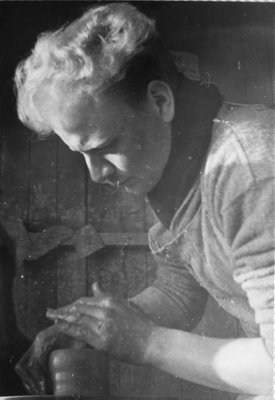 After such a night I slept in and coming from the shower with a towel round my waist I met one of the staff. “Why are you not at work?” he asked. “Because I don’t have any clothes on,” I said, and because my answer was confident and prompt he accepted it in spite of its absurdity.
After such a night I slept in and coming from the shower with a towel round my waist I met one of the staff. “Why are you not at work?” he asked. “Because I don’t have any clothes on,” I said, and because my answer was confident and prompt he accepted it in spite of its absurdity.
I had a big surprise one evening on a walk with Henning. Suddenly he stopped me, turned me towards him and kissed me. “Are you happy now?” he said. I was more like stunned, I had no idea he was gay and I was not in love with him. Anyway we were friends and he was a nice boy, so I didn’t object and conveniently we had the workshop all to ourselves!
Oxbøl was a camp for 10,000 people created by the German army during the occupation and was now after the war being dismantled by conscientious objectors. We had to dig up old roads and separate the stones from the gravel. We were supposed to produce a certain amount of cubic feet per day, but since we were only there for a short time the staff didn’t enforce the rules strictly on us. We did some work because it was winter and we were outdoors, but mostly we were leaning on our shovels, talking and smoking cigarettes.
Oxbøl was far away from any town and in our free time we had only the entertainment offered in the camp. I chose the pottery workshop and soon became friends with the teacher, a young objector named Henning. I passed all my free time there and was assisting when the pots were fired. This was done in an old fashioned kiln fired up with wood and it was an all night project. Every ten minutes the kiln had to be stoked and in between Henning and I sat in the candlelight and drank red wine, the only ones in the camp awake and snug in the cold night.
 After such a night I slept in and coming from the shower with a towel round my waist I met one of the staff. “Why are you not at work?” he asked. “Because I don’t have any clothes on,” I said, and because my answer was confident and prompt he accepted it in spite of its absurdity.
After such a night I slept in and coming from the shower with a towel round my waist I met one of the staff. “Why are you not at work?” he asked. “Because I don’t have any clothes on,” I said, and because my answer was confident and prompt he accepted it in spite of its absurdity.I had a big surprise one evening on a walk with Henning. Suddenly he stopped me, turned me towards him and kissed me. “Are you happy now?” he said. I was more like stunned, I had no idea he was gay and I was not in love with him. Anyway we were friends and he was a nice boy, so I didn’t object and conveniently we had the workshop all to ourselves!
Monday, September 25, 2006
Wednesday, September 20, 2006
Tuesday, September 19, 2006
Monday, September 18, 2006
Graphics
One of the things I like to do is graphics, posters and layout for pamphlets and books. When I came to America in 1977 and hooked up with the people from Vajrapani Institute I did all their programs, prayer books etc. Here are examples of my work:


This is a sketch for a poster. The bell symbolizes the wisdom and the vajra or thunderbolt (laying under the bell) symbolizes the method or skillful means. Together they make the path to enlightenment:



This is a sketch for a poster. The bell symbolizes the wisdom and the vajra or thunderbolt (laying under the bell) symbolizes the method or skillful means. Together they make the path to enlightenment:

Sunday, September 17, 2006
Friday, September 15, 2006
Thursday, September 14, 2006
Tuesday, September 12, 2006
Miles (as in Miles Davis)
Monday, September 11, 2006
A Quote
In Buddhism, knowledge is regarded as an obstacle to understanding, like a block of ice that obstructs water from flowing. It is said that if we take one thing to be the truth and cling to it, even if truth itself comes in person and knocks at our door, we won’t open it. For things to reveal themselves to us, we need to be ready to abandon our views about them.
(Thich Nhat Hanh, ‘Being Peace’, Parallax Press, Berkeley, CA, 1987, p.42)
(Thich Nhat Hanh, ‘Being Peace’, Parallax Press, Berkeley, CA, 1987, p.42)
Sunday, September 10, 2006
Saturday, September 09, 2006
A House with Eyes
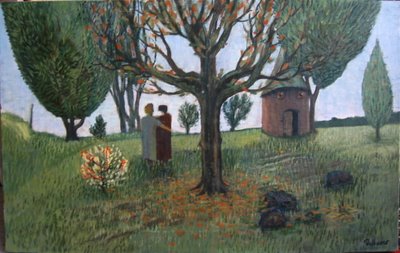 This painting was painted sometime in the mid sixties and I had completely forgotten it, but found it in the cellar of a friend. I got it back and cleaned it up, and another friend said he would like to have it on a wall.
This painting was painted sometime in the mid sixties and I had completely forgotten it, but found it in the cellar of a friend. I got it back and cleaned it up, and another friend said he would like to have it on a wall. His children complained and said it would give them nightmares.
What do you think?
Friday, September 08, 2006
Some Pictures from Denmark
Tuesday, August 15, 2006
Surf
Sunday, August 13, 2006
A Trip
After I had rested up from the flight to Denmark, I went to Sweden for a few days with my friend Georg and two of his comrades. As it turned out the purpose of this trip was: tripping! I was offered a sugarcube with guaranteed pure acid and a couple of mushrooms that according to the purveyor had to be eaten in pairs. He also said that it would not be too much and I believed him.
I should have used my brains before it got fried. It came on strong. The Swedish summer night displayed its wonders but after a while my body was in the throes of acid energy and I began to wish for it to stop. I had the feeling that I would never be able to sleep again, ever. Georg helped me to calm down with a massage but then he went to sleep and I was still there with spasms of energy cursing through me. I had to use some of this enegy and I went out in the misty morning walking through the forest to the end of our road and then back down the other way. Later the mist turned to rain and finally I slept.
Next day we were going back. I felt good and I realized that we were close to Tågarp where I lived with Don Cherry and his family in 1975. I didn't exactly remember where it would be and it is too small a village to be on the map but we found it on the first try. They were all there: Moki who was married to Don and who is a wonderful artist, Eagle Eye, and Neneh whose daughter Naima was to be married two days later. We stayed only shortly, for they were busy preparing for the wedding but it was a treat to see them.
That evening in Copenhagen I had dinner with my old friends Bent & Francoise and they had a surprise for me: they had invited Gunnar Saietz whom I hadn't seen in 32 years and Tove whom I hadn't seen in 17 years.
I have written here about Gunnar in my first post 'Labbeville' and about Tove in 'Journey to the East'
I should have used my brains before it got fried. It came on strong. The Swedish summer night displayed its wonders but after a while my body was in the throes of acid energy and I began to wish for it to stop. I had the feeling that I would never be able to sleep again, ever. Georg helped me to calm down with a massage but then he went to sleep and I was still there with spasms of energy cursing through me. I had to use some of this enegy and I went out in the misty morning walking through the forest to the end of our road and then back down the other way. Later the mist turned to rain and finally I slept.
Next day we were going back. I felt good and I realized that we were close to Tågarp where I lived with Don Cherry and his family in 1975. I didn't exactly remember where it would be and it is too small a village to be on the map but we found it on the first try. They were all there: Moki who was married to Don and who is a wonderful artist, Eagle Eye, and Neneh whose daughter Naima was to be married two days later. We stayed only shortly, for they were busy preparing for the wedding but it was a treat to see them.
That evening in Copenhagen I had dinner with my old friends Bent & Francoise and they had a surprise for me: they had invited Gunnar Saietz whom I hadn't seen in 32 years and Tove whom I hadn't seen in 17 years.
I have written here about Gunnar in my first post 'Labbeville' and about Tove in 'Journey to the East'
Thursday, August 03, 2006
A Rat Story
The last year I was at Kopan I lived in Joseph’s house, a goat shed that had been converted for human living. It contained one room and an attic, accessed by a ladder, that I used as bedroom.
In the house there was also living a rat and a small but fierce shrew. They didn’t like each other and often at night they would wake me up with their chasing around and the shrew’s piercing screams. They had made their tunnels inside the walls, which were made of stones set in mud.
One night when I was sitting on the floor eating by the light of a candle I saw the shrew and I kept very quiet. He came up to my plate, which was on the floor, and took a small helping of my food. I kind of liked the shrew; it was the rat that was a problem. He stole paper to build his nest and one time the paper was a $120 check. He also stole food and it didn’t matter where I tried to secure it; he would find a way to get it. When I had the food in a basket suspended from the ceiling in the middle of the room he apparently climbed up on a shelf and jumped from there over to the basket. Anyway the food was gone!
I was at my wits end. I must keep him busy, I thought, and that night, before I went to bed, I threw a handful of rice from the trapdoor. It worked! No more fighting, no more stealing! I guess it took him and the shrew the whole night to collect all the grains of rice. After that I daily offered a handful of rice to my housemates and we lived peacefully together to the end of my stay.
Tonight I am flying to Denmark. I am bringing my laptop but my posting will be less regular during the month I am there.
In the house there was also living a rat and a small but fierce shrew. They didn’t like each other and often at night they would wake me up with their chasing around and the shrew’s piercing screams. They had made their tunnels inside the walls, which were made of stones set in mud.
One night when I was sitting on the floor eating by the light of a candle I saw the shrew and I kept very quiet. He came up to my plate, which was on the floor, and took a small helping of my food. I kind of liked the shrew; it was the rat that was a problem. He stole paper to build his nest and one time the paper was a $120 check. He also stole food and it didn’t matter where I tried to secure it; he would find a way to get it. When I had the food in a basket suspended from the ceiling in the middle of the room he apparently climbed up on a shelf and jumped from there over to the basket. Anyway the food was gone!
I was at my wits end. I must keep him busy, I thought, and that night, before I went to bed, I threw a handful of rice from the trapdoor. It worked! No more fighting, no more stealing! I guess it took him and the shrew the whole night to collect all the grains of rice. After that I daily offered a handful of rice to my housemates and we lived peacefully together to the end of my stay.
Tonight I am flying to Denmark. I am bringing my laptop but my posting will be less regular during the month I am there.
Wednesday, August 02, 2006
Tuesday, August 01, 2006
Dream
Sunday, July 30, 2006
Subtle Energy (a quote)
In the religious and medical traditions of Asia, the human person was said to have three sources of energy: sexual, breath, and spirit. Sexual energy is what you spend during sexual intercourse. Breath energy is the kind of energy you spend when you talk too much and breathe too little. Spirit energy is energy that you spend when you worry too much, and do not sleep well. If you spend these three sources of energy, your body is not strong enough for the realization of the Way and a deep penetration into reality. Buddhist monks observe celibacy, not because of moral admonition, but for conservation of energy.
(Thich Nhat Hanh, ‘Being Peace’, Parallax Press, Berkeley, CA, 1987, p.100-101)
(Thich Nhat Hanh, ‘Being Peace’, Parallax Press, Berkeley, CA, 1987, p.100-101)
Friday, July 28, 2006
Thursday, July 27, 2006
Painting a Thanka
Wednesday, July 26, 2006
Live in the Spirit (a quote)
Live in the spirit, say the grandfathers; the spirit never will demand a surrender of your reason or deny you any urge. Whoever says that man shall suspend his reasoning looks for ways of stifling the spirit, and whoever says that man shall repress his natural desires hunts ways for killing joy.
From Ruth Beebe Hill's ‘Hanta Yo’ (Clear the Way), An American Saga.
From Ruth Beebe Hill's ‘Hanta Yo’ (Clear the Way), An American Saga.
Tuesday, July 25, 2006
Monday, July 24, 2006
JOURNEY TO THE EAST 8
Back in Bodhanath I decided to go and see Bhagawan Dass, but when I came to Kopan he was not home. I was about to leave when a tall handsome American woman with a crew cut and dressed in Tibetan robes called me back.
“I am Zina,” she said, “but you can call me mother! What are your plans?”
“I am soon going back to India,” I said.
“That is not a good idea,” she said. “The rainy season is unbearable, it is too hot. You should stay here, the monsoon is very pleasant here.”
“But my visa is running out.”
“I can help you with a visa.”
“But I have no money.”
“I can help you with money, and you can stay here for free. I’ll give you a room and money every month.”
She took me round to the secluded south side of the house and showed me a large airy room. “This is the best room, it just needs to be cleaned, then you can stay here. And you can meet the Lamas; they are not here now, but they are coming soon.”
This is how I came to stay at Kopan.
When I arrived a week later my room was not yet ready and Zina asked me I if I would mind sharing a room with Michael a few days. “Michael is in silence,” she said, “and it will only be a couple of days anyway!”
Michael Hollingshead, a baldish and bearded hippie about my age, was actually trying to kick a heroin habit, and he was not ready to be silent. From the moment I became his roommate he made use of my voice; he was constantly writing notes asking me to tell the cook this and ask Zina that. When I came back from a trip to Katmandu, quite exhausted, he had spread his papers all over the room, and there was hardly space to sit down, let alone to rest. The days passed without my room being ready, and I was about to give up, but I had read a word by the Buddha: “If you are not able to live with demons, you cannot find enlightenment.” Finally after five days I lost my patience and called on Zina: “Michael is driving me crazy, you have to get my room ready tomorrow.” Michael was angry that I had complained, but at least that made him stop writing notes, and the following day I got my room and peace was restored.
The rainy season went by quietly. The weather was pleasant; it didn’t rain too much, often just a short violent storm late in the afternoon that left the air fresh and balmy. Zina gave me small artistic jobs to do for her, and it felt good to finally settle down. I started sewing handbags with embroidery in Tibetan style to sell. The promised money from Zina did not always show up, but with board and lodging free I didn’t need much.
 When the rains stopped the lamas arrived. Geshe Thubten Yeshe and Thubten Zopa Rimpoche, as they were introduced by Mother Zina - whom nobody ever called Mother. She liked to give names. She referred to me as ‘our Babaji’, and Babaji became my name. On Thubten Yeshe she conferred the title of Geshe though he had not actually taken the Geshe degree, which is like a doctorate. He was 35 years old, and at first he just seemed to be another extremely friendly Tibetan, as all the ones I had met on my trek had been. Thubten Zopa was young and good-looking and his whinnying laughter sounded ever so often. We all had our meals together, and I soon came to feel very comfortable with Thubten Yeshe whose down-to-earth manner fitted well with my Taurean nature.
When the rains stopped the lamas arrived. Geshe Thubten Yeshe and Thubten Zopa Rimpoche, as they were introduced by Mother Zina - whom nobody ever called Mother. She liked to give names. She referred to me as ‘our Babaji’, and Babaji became my name. On Thubten Yeshe she conferred the title of Geshe though he had not actually taken the Geshe degree, which is like a doctorate. He was 35 years old, and at first he just seemed to be another extremely friendly Tibetan, as all the ones I had met on my trek had been. Thubten Zopa was young and good-looking and his whinnying laughter sounded ever so often. We all had our meals together, and I soon came to feel very comfortable with Thubten Yeshe whose down-to-earth manner fitted well with my Taurean nature.
“I am Zina,” she said, “but you can call me mother! What are your plans?”
“I am soon going back to India,” I said.
“That is not a good idea,” she said. “The rainy season is unbearable, it is too hot. You should stay here, the monsoon is very pleasant here.”
“But my visa is running out.”
“I can help you with a visa.”
“But I have no money.”
“I can help you with money, and you can stay here for free. I’ll give you a room and money every month.”
She took me round to the secluded south side of the house and showed me a large airy room. “This is the best room, it just needs to be cleaned, then you can stay here. And you can meet the Lamas; they are not here now, but they are coming soon.”
This is how I came to stay at Kopan.
When I arrived a week later my room was not yet ready and Zina asked me I if I would mind sharing a room with Michael a few days. “Michael is in silence,” she said, “and it will only be a couple of days anyway!”
Michael Hollingshead, a baldish and bearded hippie about my age, was actually trying to kick a heroin habit, and he was not ready to be silent. From the moment I became his roommate he made use of my voice; he was constantly writing notes asking me to tell the cook this and ask Zina that. When I came back from a trip to Katmandu, quite exhausted, he had spread his papers all over the room, and there was hardly space to sit down, let alone to rest. The days passed without my room being ready, and I was about to give up, but I had read a word by the Buddha: “If you are not able to live with demons, you cannot find enlightenment.” Finally after five days I lost my patience and called on Zina: “Michael is driving me crazy, you have to get my room ready tomorrow.” Michael was angry that I had complained, but at least that made him stop writing notes, and the following day I got my room and peace was restored.
The rainy season went by quietly. The weather was pleasant; it didn’t rain too much, often just a short violent storm late in the afternoon that left the air fresh and balmy. Zina gave me small artistic jobs to do for her, and it felt good to finally settle down. I started sewing handbags with embroidery in Tibetan style to sell. The promised money from Zina did not always show up, but with board and lodging free I didn’t need much.
 When the rains stopped the lamas arrived. Geshe Thubten Yeshe and Thubten Zopa Rimpoche, as they were introduced by Mother Zina - whom nobody ever called Mother. She liked to give names. She referred to me as ‘our Babaji’, and Babaji became my name. On Thubten Yeshe she conferred the title of Geshe though he had not actually taken the Geshe degree, which is like a doctorate. He was 35 years old, and at first he just seemed to be another extremely friendly Tibetan, as all the ones I had met on my trek had been. Thubten Zopa was young and good-looking and his whinnying laughter sounded ever so often. We all had our meals together, and I soon came to feel very comfortable with Thubten Yeshe whose down-to-earth manner fitted well with my Taurean nature.
When the rains stopped the lamas arrived. Geshe Thubten Yeshe and Thubten Zopa Rimpoche, as they were introduced by Mother Zina - whom nobody ever called Mother. She liked to give names. She referred to me as ‘our Babaji’, and Babaji became my name. On Thubten Yeshe she conferred the title of Geshe though he had not actually taken the Geshe degree, which is like a doctorate. He was 35 years old, and at first he just seemed to be another extremely friendly Tibetan, as all the ones I had met on my trek had been. Thubten Zopa was young and good-looking and his whinnying laughter sounded ever so often. We all had our meals together, and I soon came to feel very comfortable with Thubten Yeshe whose down-to-earth manner fitted well with my Taurean nature.
Sunday, July 23, 2006
Saturday, July 22, 2006
Friday, July 21, 2006
Friday Night
 Melanie making up. The house is glowing and warm in the summer night.
Melanie making up. The house is glowing and warm in the summer night. My two housemates are ready for Friday night.
My two housemates are ready for Friday night. I stay home and technically babysit with a monitor. But the kids have been properly tired out and there is not a sound to be heard from them.
Tonight I worship the green Goddess, Purveyor and Protector of Dreams manifest in Beauty.
I am listening to Aziza, the group I was studying with in Africa in 02. It rocks! Their music, which takes material from different tribes in Ghana, has wonderful singing and mesmerizing drums. I have danced to some of these rhythms.
And then I am blogging;
I think blogger-thoughts;
I think about the connection with you my friends and readers who tell me from time to time that you are visiting here; I thank you!
And thank you to you who just drop in!
And thank you to you who have commented - (that's you, Sue ;-)
I must concede that I don't leave many comments with others, so I guess I don't deserve them.
Talking blogger-talk is a sign that one has been infected with bloggeritis.
JOURNEY TO THE EAST 7
(Scroll down to read the previous accounts of the Journey to the East)
It was my plan to trek in the high mountains before my return to India. Torben took a photo of our departure showing Tove and Jytte walking with a group of barefoot sadhus in orange robes, from left: Fut, Niels Ebbe, Hurtigkarl who cannot be seen except for his feet, Tove, me with a big basket à la Newari, Jytte and John. Most of them were seeing us off, only Niels Ebbe and Hurtigkarl was going on the trek; both of them I hardly knew, and Niels Ebbe I didn’t particularly like, but they were not going as far as I, who had planned to reach Junbesi, the first Sherpa village in a valley. A few days out we were sitting in a small settlement when we spotted a figure coming down the trail. It was a tall blond boy dressed in a white dhoti and with a crown of dreads. “Bhagawan Dass,” said Niels Ebbe. In ‘Be Here Now’ by Ram Dass I had read about Bhagawan Dass; the boy that set Richard Alpert on his path and brought him to his guru, and I had heard that he was around. It is always an occasion when you meet another traveler out in the mountains, and we ordered tea and sat smoking and talking for a couple of hours until we had to continue each his way. Bhagawan Dass said to come and see him when I returned, he was staying at Kopan, and when he described how to get there, I recognized the hidden house on the hill.
A few days out we were sitting in a small settlement when we spotted a figure coming down the trail. It was a tall blond boy dressed in a white dhoti and with a crown of dreads. “Bhagawan Dass,” said Niels Ebbe. In ‘Be Here Now’ by Ram Dass I had read about Bhagawan Dass; the boy that set Richard Alpert on his path and brought him to his guru, and I had heard that he was around. It is always an occasion when you meet another traveler out in the mountains, and we ordered tea and sat smoking and talking for a couple of hours until we had to continue each his way. Bhagawan Dass said to come and see him when I returned, he was staying at Kopan, and when he described how to get there, I recognized the hidden house on the hill.
After a few more days my companions turned around, and I was on my own. The path went over ridge upon ridge. In the valleys lived the Hindus, but on top of the ridges I began to come upon Sherpa settlements. The Sherpas have been in the high parts of the Nepali Himalayas for the last 2-300 years. They migrated from Tibet and their language, culture, and religion are still Tibetan. Finally, in Junbesi, even the bottom of the valley is so elevated that the Sherpas have settled here. I stayed with a family for a few days and did a trek up the valley to the famous monastery Thubten Chöling. It is a beautiful lush valley, and it has a homey feeling for a Scandinavian person. When I began my trek home a little servant boy from the family I had stayed with caught up with me and insisted on following me. He had a tough life and I had been kind to him, so he had decided to throw his lot in with me. The next day he began to get doubts, and when we met a man from Junbesi he agreed to return with him.
I had been walking barefoot all the way and had constant trouble with my feet. On the way back I also got a stomach infection and could not keep anything in me. I felt weak, but there was no alternative, I had to go on. The last day, on the way slowly up the last ridge, I met an American who gave me a bag of trail mix. That proved to be the first food that didn’t go right through me, and it gave me good energy so that I strode along the ridge and arrived at the paved road with my stomach back in order and my feet tough and for the first time without any sores.
It was my plan to trek in the high mountains before my return to India. Torben took a photo of our departure showing Tove and Jytte walking with a group of barefoot sadhus in orange robes, from left: Fut, Niels Ebbe, Hurtigkarl who cannot be seen except for his feet, Tove, me with a big basket à la Newari, Jytte and John. Most of them were seeing us off, only Niels Ebbe and Hurtigkarl was going on the trek; both of them I hardly knew, and Niels Ebbe I didn’t particularly like, but they were not going as far as I, who had planned to reach Junbesi, the first Sherpa village in a valley.
 A few days out we were sitting in a small settlement when we spotted a figure coming down the trail. It was a tall blond boy dressed in a white dhoti and with a crown of dreads. “Bhagawan Dass,” said Niels Ebbe. In ‘Be Here Now’ by Ram Dass I had read about Bhagawan Dass; the boy that set Richard Alpert on his path and brought him to his guru, and I had heard that he was around. It is always an occasion when you meet another traveler out in the mountains, and we ordered tea and sat smoking and talking for a couple of hours until we had to continue each his way. Bhagawan Dass said to come and see him when I returned, he was staying at Kopan, and when he described how to get there, I recognized the hidden house on the hill.
A few days out we were sitting in a small settlement when we spotted a figure coming down the trail. It was a tall blond boy dressed in a white dhoti and with a crown of dreads. “Bhagawan Dass,” said Niels Ebbe. In ‘Be Here Now’ by Ram Dass I had read about Bhagawan Dass; the boy that set Richard Alpert on his path and brought him to his guru, and I had heard that he was around. It is always an occasion when you meet another traveler out in the mountains, and we ordered tea and sat smoking and talking for a couple of hours until we had to continue each his way. Bhagawan Dass said to come and see him when I returned, he was staying at Kopan, and when he described how to get there, I recognized the hidden house on the hill.After a few more days my companions turned around, and I was on my own. The path went over ridge upon ridge. In the valleys lived the Hindus, but on top of the ridges I began to come upon Sherpa settlements. The Sherpas have been in the high parts of the Nepali Himalayas for the last 2-300 years. They migrated from Tibet and their language, culture, and religion are still Tibetan. Finally, in Junbesi, even the bottom of the valley is so elevated that the Sherpas have settled here. I stayed with a family for a few days and did a trek up the valley to the famous monastery Thubten Chöling. It is a beautiful lush valley, and it has a homey feeling for a Scandinavian person. When I began my trek home a little servant boy from the family I had stayed with caught up with me and insisted on following me. He had a tough life and I had been kind to him, so he had decided to throw his lot in with me. The next day he began to get doubts, and when we met a man from Junbesi he agreed to return with him.
I had been walking barefoot all the way and had constant trouble with my feet. On the way back I also got a stomach infection and could not keep anything in me. I felt weak, but there was no alternative, I had to go on. The last day, on the way slowly up the last ridge, I met an American who gave me a bag of trail mix. That proved to be the first food that didn’t go right through me, and it gave me good energy so that I strode along the ridge and arrived at the paved road with my stomach back in order and my feet tough and for the first time without any sores.
Thursday, July 20, 2006
Abortion (a quote)
Abortion is sometimes necessary, sometimes not, always sad. It is to the woman as war is to the man – a living sacrifice in a cause justified or not justified, as the observer may decide. It is the making of hard decisions – that this one must die that that one can live in honor and decency and comfort. Women have no leaders; a woman’s conscience must be her General. There are no stirring songs to make the task of killing easier, no victory marches and medals handed round afterwards, merely a sense of loss.
(Fay Weldon, ‘The Hearts and Lives of Men’, p.65)
(Fay Weldon, ‘The Hearts and Lives of Men’, p.65)
Wednesday, July 19, 2006
Tuesday, July 18, 2006
Monday, July 17, 2006
Sunday, July 16, 2006
JOURNEY TO THE EAST 6
In the spring of 1970 I went to Nepal with an old friend, the Danish photographer Torben Huss. We went by Varanasi where we spent a day, then by train to the Nepalese border. Here we were looking for a ride with a truck and were shown where to ask in a store. There was a flock outside; two Americans were complaining and whining: “You said you were going at ten. Now it is noon; when are you going?” - “Why don’t you keep to the agreement?” - “How long is it going to last?”
The rest of the flock was listening, and so were we. The drivers sat on the floor working on a tire and they didn’t even look up. Finally the Americans gave up and left, and the crowd dispersed. When we were the only ones left, we asked if they were going to Katmandu, and they said, yes, they were leaving soon, and, yes, we could get a ride.
It was a glorious ride; most of the way we sat on top of the drivers cap while the heavily loaded truck ground up the winding road through the shining mountains. We reached the top as the sun went down and passed the night on the ground next to the truck.
Next morning we arrived in Katmandu and Torben, who had been there in the early sixties, just after Nepal was opened for travelers, could not recognize the town, so many new buildings had grown up. We found the mini-bus to Bodhanath that is not far from Katmandu. Where we got off the bus, there were a few houses along the road.
 Between two of them an opening lead in to the gigantic stupa whose golden upper part was decorated with the serene eyes of the Buddha. The stupa was surrounded by one circle of houses, and this was the whole town of Bodhanath. Monks and nuns and lay Tibetans were circling the stupa, keeping it on their right side; some had prayer wheels, others were turning the prayer wheels that were set in the wall all the way around. We circled a couple of times and went through a narrow passage on the opposite side from the road and came out on a path through the rice fields. After a few minutes walk we found John’s house where we were going to stay.
Between two of them an opening lead in to the gigantic stupa whose golden upper part was decorated with the serene eyes of the Buddha. The stupa was surrounded by one circle of houses, and this was the whole town of Bodhanath. Monks and nuns and lay Tibetans were circling the stupa, keeping it on their right side; some had prayer wheels, others were turning the prayer wheels that were set in the wall all the way around. We circled a couple of times and went through a narrow passage on the opposite side from the road and came out on a path through the rice fields. After a few minutes walk we found John’s house where we were going to stay.
Looking from the house, away from the stupa towards the mountains in the north, there was a small hill with a flat top with two great trees. Just as Sidi Ali had called me when I was in Meknès, this hill called me now, and one day, when I was smoothly coming down from an acid-trip, I obeyed the call. With brisk energy I completed the half hour walk up there before the sunset. I sat by a small shrine on the west side and saw the sun set behind the glittering golden towers of Katmandu showing the hill of Swayambunath in silhouette. Before leaving I looked around. There was a marvelous view of the whole valley from the top of the hill, and on the south side I found a half open gate, through which I spied an old house, hiding behind tall hedges.
The rest of the flock was listening, and so were we. The drivers sat on the floor working on a tire and they didn’t even look up. Finally the Americans gave up and left, and the crowd dispersed. When we were the only ones left, we asked if they were going to Katmandu, and they said, yes, they were leaving soon, and, yes, we could get a ride.
It was a glorious ride; most of the way we sat on top of the drivers cap while the heavily loaded truck ground up the winding road through the shining mountains. We reached the top as the sun went down and passed the night on the ground next to the truck.
Next morning we arrived in Katmandu and Torben, who had been there in the early sixties, just after Nepal was opened for travelers, could not recognize the town, so many new buildings had grown up. We found the mini-bus to Bodhanath that is not far from Katmandu. Where we got off the bus, there were a few houses along the road.
 Between two of them an opening lead in to the gigantic stupa whose golden upper part was decorated with the serene eyes of the Buddha. The stupa was surrounded by one circle of houses, and this was the whole town of Bodhanath. Monks and nuns and lay Tibetans were circling the stupa, keeping it on their right side; some had prayer wheels, others were turning the prayer wheels that were set in the wall all the way around. We circled a couple of times and went through a narrow passage on the opposite side from the road and came out on a path through the rice fields. After a few minutes walk we found John’s house where we were going to stay.
Between two of them an opening lead in to the gigantic stupa whose golden upper part was decorated with the serene eyes of the Buddha. The stupa was surrounded by one circle of houses, and this was the whole town of Bodhanath. Monks and nuns and lay Tibetans were circling the stupa, keeping it on their right side; some had prayer wheels, others were turning the prayer wheels that were set in the wall all the way around. We circled a couple of times and went through a narrow passage on the opposite side from the road and came out on a path through the rice fields. After a few minutes walk we found John’s house where we were going to stay.Looking from the house, away from the stupa towards the mountains in the north, there was a small hill with a flat top with two great trees. Just as Sidi Ali had called me when I was in Meknès, this hill called me now, and one day, when I was smoothly coming down from an acid-trip, I obeyed the call. With brisk energy I completed the half hour walk up there before the sunset. I sat by a small shrine on the west side and saw the sun set behind the glittering golden towers of Katmandu showing the hill of Swayambunath in silhouette. Before leaving I looked around. There was a marvelous view of the whole valley from the top of the hill, and on the south side I found a half open gate, through which I spied an old house, hiding behind tall hedges.
Saturday, July 15, 2006
Subscribe to:
Posts (Atom)






